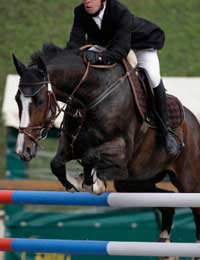Showjumping Rules

Every club will organise a showjumping competition every once in a while. Some clubs may alter the rules slightly to suit their own purposes but the official British Showjumping Association (BSJA) contests must adhere to the BSJA rules, as must BSJA qualifying rounds. The Federation Equestrian Internationale (FEI) covers the rules for international competitions including the Olympics, but also any other contest with teams from different countries.
What do the Rules Cover?
As with any sport, the rules cover a massive amount of ground. In showjumping this is perhaps more than most because of the addition of the horse – whose welfare is important and who must be looked after.There is also a vast amount of equipment involved in showjumping. It is all regulated in the official rule book. This covers saddles, bridles and the rest of the tack. Clothing is particularly important and the rule book has strict regulations about what can be worn, including types of hat, even down to the British safety standard you must have.
Obviously, the rule book also covers the actual sport rules. This will include what constitutes a clear round and what powers the judges have. The rules cover qualifying and how to do it – and the maximum and minimum heights of fences in each round and stage. In addition, they tell you who can jump in each particular stage. This can be particularly complicated because the age and experience of the horse as well as the rider comes into play.
The History of the Rules
The rule book is updated and amended every year. If you are not sure whether you have the most up to date rule book, then check on the BSJA website. They issue a list of amendments every year which is usually uploaded onto the site.The rules themselves have come a long way since the beginning of showjumping and the inception of the BSJA. In fact, the BSJA came into being largely to deal with the problem of an unregulated system of competitions and come up with the official rules. The first rule book in 1925 was basic. It awarded penalty points according to which leg hit the jumps as the horse was going over – this was based, somewhat oddly, on the values of horsemanship and riding treasured in hunting, a very different discipline to jumping.
It is easy to see the advantages of having a standardised set of rules. All competitors should at least be familiar with the rule book. No-one will be expected to know it inside out apart from judges and other senior figures in the sport. But this is no excuse for not having a working knowledge of the rules of the sport. Generally speaking, most people competing in showjumping should know the rules of the sport itself, and what is required of them. But a rule book should always be handy so those who are not sure can check such technical details as how old their horse needs to be to compete in a certain competition or what colours their breeches are allowed to be for qualifying.


Re: Body Protectors and Back Support
When wearing my back protector, my lower back actually hurts more. What should I do?
Re: How Riders Use Stirrups
Thank you for article. Could you elaborate more on why we use stirrups. Every search of "why we use stirrups" only gave a few sentence…
Re: Mucking Out
How old do you have to be able to do stable hand ?
Re: Showjumping: Where to Start
To compete at high levels in showjumping is it easier to have your own horse, share or loan? Thanks
Re: What Equipment Will You Need?
i have just starting riding only had one lesson already got the boots jodphurshat polo and whip im really serious about this
Re: What to Wear as a Beginner
I am a beginner and I was wondering what are the best joppers , gloves .etc. that I could buy could you help me.
Re: What Equipment Will You Need?
I found this very good because my daughter is at cantering stage and we were thinking about getting her a horse although did not…
Re: Riding Hats
I don't jump yet but I do a lot of canter work in my lessons. Do I need a body protector or not?
Re: What Equipment Will You Need?
I never had to use a helmet, crop, or proper clothing while training my horses. When I first got my Arabian cross she was crazy,…
Re: Horse Boxes and Trailers
@Darren - there are places that give horsebox driver training, so that you can drive with confidence, as it can be a stressful…